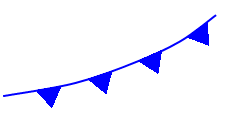Heat always flows from ____ to ______.
hot, cold
What is the difference between weather and climate?
Climate is the average weather over a long period of time (years). Weather describes the short term state of weather (current, yesterday, etc.)
 What does this symbol mean?
What does this symbol mean?
Cold Front
Snow and hail are examples of what part/process of the water cycle?
Precipitation
What type of clouds are puffy and white?
Cumulus
What are the three types of heat transfer?
Conduction, Convection, and Radiation
What kind of weather would result from a low-pressure weather system?
Cloudy, Stormy weather conditions
What kind of weather does a cold front bring?
Warm, moist weather. Light rain or snow
What is the main source of energy for the water cycle? It powers the water cycle!
The Sun
What kind of weather would you find with cumulonimbus clouds?
Stormy
A pot is heated on a stove. Which heat transfer process causes the metal handle of the pot to also become hot?
Conduction
It's currently summer in the northern hemisphere. Andy lives in the southern hemisphere. What season does he most likely have in August?
What weather instrument measures air pressure?
Barometer
When water changes from a liquid to a gas in the water cycle, this is called condensation.
True or False?
False. It is evaporation
What are clouds made up of?
Tiny water droplets
Fill in the blanks:
Warm air ______ , Cool air _______
rises, sinks
Which has the greatest effect on wind speed?
a. precipitation
b. cloud cover
c. wind direction
d. air pressure
D.
Air pressure
What weather element does an anemometer measure?
Wind speed
What is the correct water cycle term for rising water vapor meeting colder air and turning back into water droplets?
Condensation
What type of clouds are usually found low in the sky?
Stratus
Bill stands in a swimming pool and notices that the water around his feet is a lot cooler than the water near the surface. Which heat transfer process causes this difference in temperature?
Convection
Explain the difference between El Nino and La Nina.
El Niño is a climate pattern where the water in the Pacific Ocean near the equator gets hotter than usual and affects the atmosphere and weather around the world. La Niña is sort of the opposite of El Niño. During a La Niña, the water in the same area along the equator gets colder than usual.
The jet stream forms a boundary between a ______ air mass and a ______ air mass.
cold, warm
What must occur before clouds can form?
a. Water vapor must get warmer.
b. Water vapor must lose heat energy.
c. Precipitation must begin to fall and runoff.
d. Transpiration must add water vapor to the atmosphere.
A
What type of clouds are thin and usually show a weather change?
Cirrus